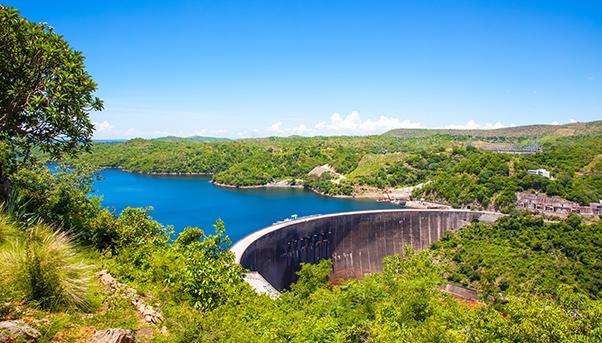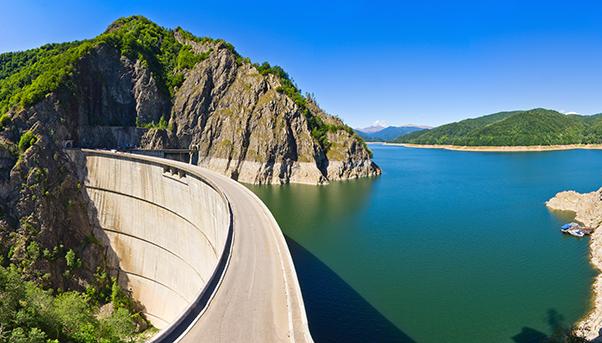
Of all the renewable energy resources deployed throughout the world, hydroelectricity is the most prevalent. It is responsible for about 16% of all the electricity produced. To harness it, there needs to be a great volume of water held back by a dam. It is released at a measured pace down a conduit at the end of which it turns turbines and generators for electricity. Once it has served its purpose, the water is allowed to return to following its natural course downstream from the dam.
It is no surprise that the world’s five biggest producers of hydroelectricity – China, Canada, Brazil, the United States and Russia – are also those with the biggest land masses and the most abundant supplies of water, whether they be in the form of lakes, rivers or glaciers. However, when ranking countries according to their reliance on hydroelectricity, a different set of names come to the fore.
Below is a list compiled by “We Build Value” from data supplied by the International Energy Agency (IEA) and the International Hydropower Association (IHA). The countries that appear on it are those for which hydroelectricity is responsible for nearly all of the electricity that they produce, making them the greenest in the world.
1. Albania
This small European country with a land mass of 28,748 square kilometres and a population of 2.8 million generates all of its electricity through the exploitation of water. With its mountainous geography and abundance of water, Albania produces 4,724 GWh and has an installed capacity of 1,527 MW, most of it concentrated along the Drin River. But the IHA estimates it is using only 30-35% of its hydro potential.
2. Paraguay
Thanks to two dams along the Paraná River - the Itaipu and Yacyretá - and another on the Acaray River, Paraguay is the 14th biggest hydroelectric producer in the world and the second to generate nearly all of its power from water. In 2014, out of a total of 55,282 GWh produced, 55,276 came from dams.
3. Democratic Republic of Congo
The country relies on the Congo River for nearly all - 99.9% - of its electricity. Along this river, which flows through 10 countries before reaching the Atlantic Ocean, there are 40 hydroelectric dams, nine of which in the country. Inga I (354 MW) and Inga 2 II (1,424 MW) are the two biggest, later to be joined by the Grand Inga project that foresees an installed capacity of 39 GW.
4. Nepal
At the end of 2015, the installed production capacity of the country, blessed by abundant water from the Himalayas, was just 753 MW. But its potential is estimated at 84 GW, half of which is deemed to be economically feasible. About 99.8% of the country’s electricity comes from hydro.
5. Namibia
Large swaths of the country might be desert, but hydroelectricity is still responsible for 99.13% of the total power produced. Nearly 60% of the amount comes from the Ruacana plant near the falls of the same name on the Cunene River.

6. Zambia
The Zambesi River, on which is built the Kariba dam (1,626 MW) is the biggest source of hydroelectric in southern Africa. Of the seven countries through which the river flows, Zambia is the biggest beneficiary with 41% of the basin, allowing it to produce 14,452 GWh, or 97.16% of the total.
7. Tajikistan
The hydroelectric potential of this country places it among the biggest in the world, even if it only has an installed capacity of 5,190 MW to this day. It produces 16,000 GWh a year or 97.13% of the total amount, two-thirds of which from the Nurek dam. Tajikistan is overseeing the construction of the Rogun dam by Salini Impregilo on the Vakhsh River. Located in the Pamir region, it will be the tallest in the world at 335 metres. The dam will have six turbines with an installed capacity of 3,600 MW, double the country’s electricity production and turning it into an energy hub for the region.
8. Norway
Even though it is a producer of oil and gas, Norway generates 96% of its electricity from hydro thanks to a network of more than 900 dams.
9. Ethiopia
It is the emerging energy powerhouse, in addition to being one of the fastest growing economies in Africa. Thanks to two main rivers – the Blue Nile and the Omo – it has a potential installed capacity of 45,000 MW, mostly unused. At the end of 2014, Ethiopia produced 9,195 GWh of hydroelectricity out of a total of 9,615 (95.6%), according to the IEA. The country is quickly developing its hydroelectric potential. At the end of 2015, it had an installed capacity of 2,552 MW. In 2016, the Gibe III dam came into operation (1,870 MW) while another 6,000 MW will be coming on line from the Grand Ethiopian Renaissance Dam (GERD), set to be Africa’s biggest.
10. Kyrgyzstan
Thanks to its mountainous terrain and enormous supply of water, the country has the potential to generate electricity. But the exploitation of this renewable resource has been delayed by a series of problems in investment and lack of maintenance of old plants dating back to Soviet times. At the moment, it produces 13,298 GWh, 91.3% of the total


